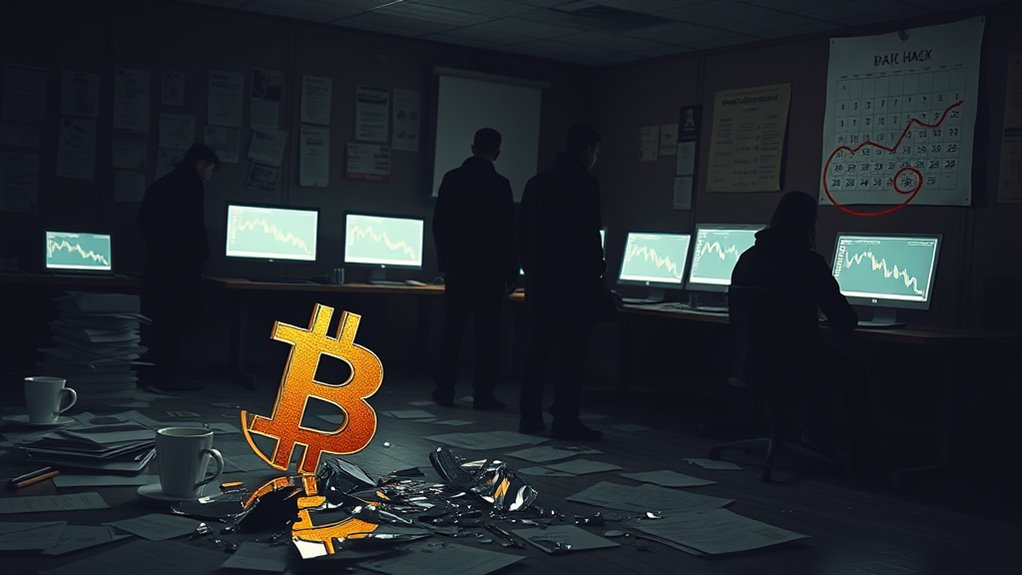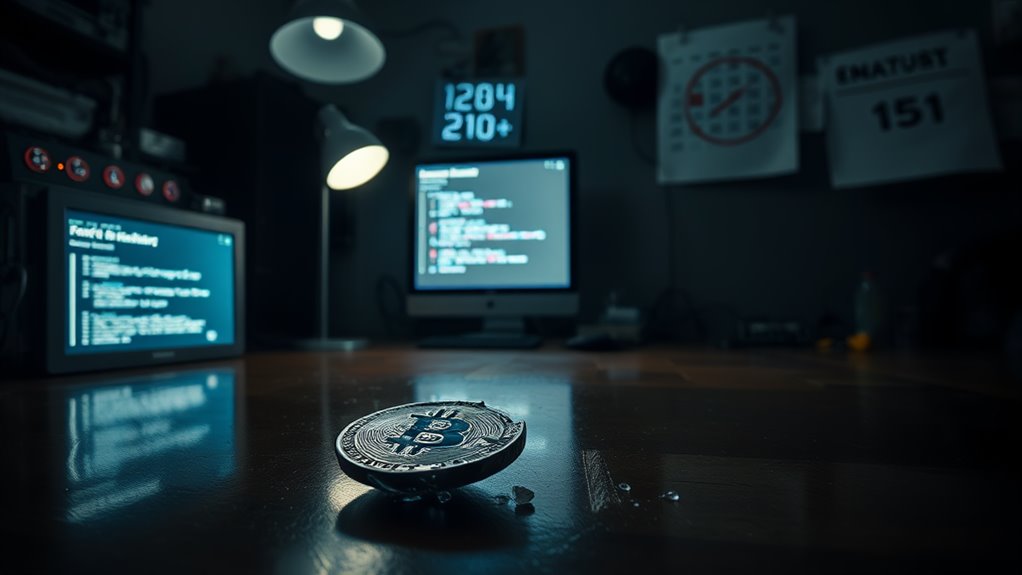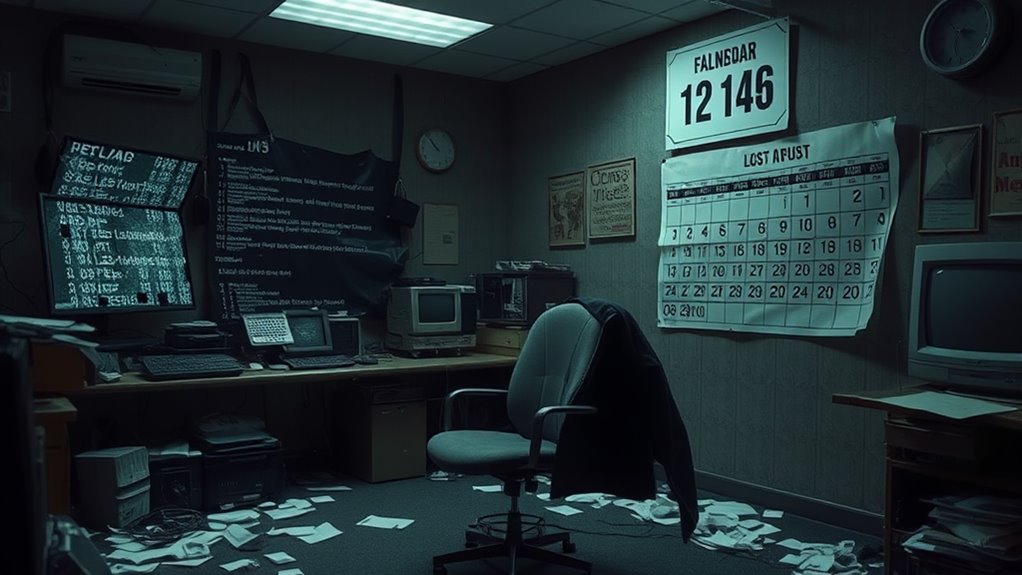
Mt. Gox Hack: The Fall of a Crypto Giant
The fall of Mt. Gox, once the leading Bitcoin exchange, resulted from multiple security breaches and management failures. It was established in 2006 and shifted to cryptocurrency by 2010, controlling over 70% of Bitcoin transactions by 2013. However, a catastrophic 2014 hack saw 850,000 BTC stolen, causing massive financial losses and eroding user trust. Legal consequences soon followed, leading to bankruptcy filings. This incident ultimately shaped the future of cryptocurrency exchanges and regulations, hinting at deeper lessons ahead.
Table of Contents
Key Takeaways
- Mt. Gox, once handling over 70% of Bitcoin transactions, fell victim to a massive hack in February 2014, losing 850,000 BTC.
- Early security breaches in 2011 revealed systemic vulnerabilities, eroding customer confidence and leading to frequent technical issues.
- The 2014 hack, marked by poor security protocols and mismanagement, resulted in a significant market decline and loss of trust in exchanges.
- Legal consequences ensued for CEO Mark Karpelès, who faced embezzlement charges, highlighting a lack of transparency and accountability.
- The fallout prompted a shift towards decentralized finance and increased regulatory scrutiny to protect investors in the cryptocurrency space.
The Rise and Fall of Mt. Gox

The rise and fall of Mt. Gox illustrates a significant chapter in the evolution of cryptocurrency exchanges. Originally established by Jed McCaleb in 2006 for trading “Magic: The Gathering” cards, the platform transformed into a Bitcoin exchange in 2010.
After Mark Karpelès acquired Mt. Gox in 2011, it rapidly gained prominence, handling over 70% of global Bitcoin transactions by early 2013. Operating from Tokyo, the exchange became synonymous with Bitcoin trading, contributing to fluctuations in the asset’s price.
However, by early 2014, Mt. Gox faced severe operational issues, leading to the suspension of trading and a bankruptcy filing. The loss of approximately 850,000 Bitcoins profoundly damaged its reputation and impacted the broader cryptocurrency market, marking a cautionary tale in digital finance.
Early Security Breaches and Warning Signs

Although Mt. Gox initially gained popularity in the cryptocurrency market, it faced early security breaches that signaled deeper issues.
The first known incident occurred in June 2011 when hackers accessed an auditor’s computer, manipulating Bitcoin prices and allowing unauthorized transfers of about 2,000 BTC. This breach, along with the theft of 25,000 BTC later that year, exposed systemic vulnerabilities within Mt. Gox’s operations.
Poor maintenance and inadequate security measures led to repeated attacks, including unauthorized access to user data. Customers began losing confidence due to slow transaction processing and data leaks.
Inadequate security and poor maintenance eroded customer trust, leading to slow transactions and alarming data leaks.
Despite these warning signs, many investors continued using the platform, as alternatives were limited, which ultimately contributed to the exchange’s downfall.
The Catastrophic 2014 Hack

In February 2014, the cryptocurrency world was rocked by a significant event that would change the landscape of digital currency exchanges forever. Mt. Gox, one of the largest Bitcoin exchanges at the time, reported the theft of 850,000 BTC, valued at hundreds of millions of dollars.
Although the hack had occurred over several years, its discovery led to immediate panic as only 200,000 BTC were recovered. The exchange’s system misinterpreted the stolen coins as internal transfers, delaying awareness of the breach.
This incident not only marked the largest Bitcoin theft in history but also severely undermined trust in cryptocurrency exchanges, resulting in market declines and increased regulatory scrutiny as investors faced growing concerns about security and oversight.
Mismanagement and Legal Consequences

Mismanagement plagued Mt. Gox from its early days, as security issues and inadequate protocols left it vulnerable to breaches. Users experienced frequent technical problems and withdrawal delays, which pointed to deeper operational flaws.
The structure of Mt. Gox introduced significant custodial and counterparty risks, eroding user trust over time. Financial irregularities came to light when Mark Karpeles faced charges of embezzlement, revealing unauthorized movements of user funds and a lack of transparency.
As Mt. Gox filed for bankruptcy in both Japan and the United States, numerous lawsuits emerged from former users seeking restitution. The resulting legal battles complicated the resolution process, ultimately highlighting the severe consequences of mismanagement within the platform.
Lasting Impact on the Crypto Landscape

The Mt. Gox hack had a profound and lasting impact on the cryptocurrency landscape. It eroded investor trust and raised awareness of the vulnerabilities in centralized exchanges, leading to increased anxiety among users. Many lost substantial savings, prompting a shift in security practices across the industry. Furthermore, the incident highlighted the need for better understanding of regulations and tax laws, which are crucial for safeguarding investors in the cryptocurrency market.
| Impact | Description | Emotional Response |
|---|---|---|
| Loss of Trust | Significant erosion of confidence in exchanges | Fear and uncertainty |
| Enhanced Security Measures | Adoption of stronger security protocols | Relief and cautious optimism |
| Market Volatility | Increased fluctuations in cryptocurrency prices | Frustration and concern |
The incident catalyzed regulatory scrutiny and a growing interest in decentralized finance, ultimately shaping a more resilient crypto market.
Frequently Asked Questions
What Was the Original Purpose of Mt. Gox Before Cryptocurrency?
Initially, Mt. Gox was intended as a trading platform for Magic: The Gathering Online cards. Created in 2006, it struggled to gain traction and was eventually abandoned by its founder, Jed McCaleb.
How Did Mt. Gox’s Ownership Change in 2011?
In 2011, ownership of Mt. Gox changed from Jed McCaleb to Mark Karpelès. McCaleb sold due to time constraints, while Karpelès, residing in Japan, aimed to expand the exchange’s potential and user base considerably.
What Regulatory Changes Followed the Mt. Gox Incident?
Following the incident, regulatory changes included stricter oversight, mandatory registration for exchanges, enhanced security protocols like multi-signature wallets, and requirements for consumer protection measures, fostering a safer environment for cryptocurrency trading globally.
How Many Bitcoins Were Recovered After the Bankruptcy?
Approximately 140,000 Bitcoins were recovered during the bankruptcy proceedings. This significant recovery represents a substantial portion of lost assets, highlighting the complexities involved in tracing and reclaiming digital currencies after major financial disruptions.
What Security Measures Are Now Standard for Exchanges?
Standard security measures for exchanges now include multi-factor authentication, cold storage, encryption, access controls, real-time monitoring, and regular audits. These practices aim to enhance protection against cyber threats and guarantee asset safety for users.
Conclusion
To sum up, the saga of Mt. Gox serves as a cautionary tale for the cryptocurrency world. While its rise was meteoric, the subsequent fall reveals how negligence and poor security can lead to disaster. One might say that Mt. Gox was a pioneer in demonstrating how not to handle digital assets. As the crypto landscape continues to evolve, it is clear that learning from the mistakes of the past is essential to prevent history from repeating itself.



